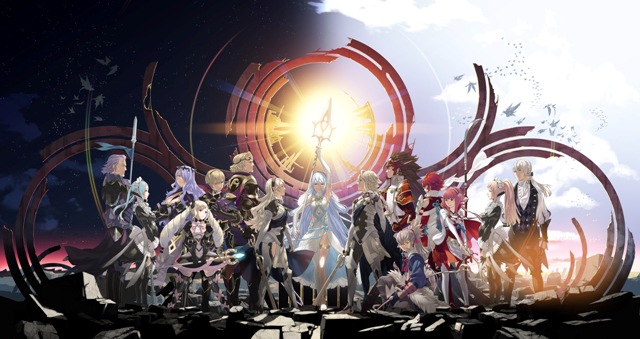Fire Emblem Fates: Fates Worth Exploring
The image features the Birthright and Conquest versions of the game on the side, with a subtle hint at Revelation in the middle.
April 21, 2016
The Fire Emblem series is a remarkable story of east meets west. For years the games were Japanese exclusive and Americans remained blissfully unaware of the games. That is until Super Smash Bros Melee, and two characters from the series made an appearance in the game. Marth and Roy, two lords from Fire Emblem games were playable characters for the first time in English. This gave the games the marketing boost they needed, and the seventh game in the series was the first to be released internationally.
Despite moderate success, the series sales started to wane and in 2012 Fire Emblem Awakening was released with a stretch goal of 200,000 sales, the series would cease production. However, the dev team didn’t tell this to the market, so it was entirely up to the game’s quality and fan reception as to the survival of the franchise.
Luckily, the game sold over 2 million copies worldwide, and the series went from a cult favorite to a main stream series of Nintendo. Now they have over five representatives in Smash Bros including Corrin, the new main character of the series from Fire Emblem 14, or as it’s known in the West, Fire Emblem Fates.
Fates is unique in that it is the first in the series to have a branching story, based around three choices you are presented with. As Corrin, you start the game in the country of Nohr, learning about how you’ve grown up there with a strict father ruling the country. Your siblings are far more accepting of you though, so you feel right at home. However, after your Father sends you on what seems to be a suicide mission, you start to question your place in the world. Eventually, you come a across the peaceful kingdom of Hosido and learn that you are actually a Hosidan price, kidnaped by Nohr at birth. At this point it is up to you to decide whether or not you pair yourself with your birth family, your adoptive family, or neither side, which leads to the most plot heavy of the three stories.
Birthright, the easiest game of the three, is still a far cry from how easy Awakening was. In Fates, they made it a point to balance the highly broken pair up system introduced in Awakening. In Awakening, only the player could pair up, and both units could attack, meaning one unit was completely safe from enemies. The paired unit could also completely block attacks for multiple attacks, leading to very broken pair ups from certain units. This also makes lunatic and lunatic plus runs of the game far easier than any other games in the series.
However, Fates rectifies this with a pair up system that revolves around offensive and defensive play. If two units are standing beside each other, they can both attack enemy units but cannot defend each other. If sharing a tile, one unit can attack, and the other can defend, represented by a blue meter under the health of a unit. Another form of balancing is that enemies can do everything you can, making combat far more of a chess match than Awakening. This a welcome addition, as I couldn’t fly through the game like Awakening, and it allowed me to get more attached to the characters that had a potential of death. Now every choice mattered, and a slight mistake could set me back several turns or cost me a unit.
Thankfully, Fates offers two modes, Casual and Phoenix, that make the game much easier, but I feel it takes out most of the satisfaction when you win a tough stage with no casualties. Thankfully, the game also offers normal, hard, and lunatic difficulties, making enemy A.I. either competent on normal, or so unfairly cheap with RNGs (Random Number Generators) you swear the game is trying to drive you insane.
Now for each game, they differ in how the world map is handled. In Birthright and Revelation, you are given options to grind on enemies in the world map and gain experience for later more challenging levels. Conquest does not, and this leads to a false sense of challenge that despite many players claiming it’s similar to the older games, which it is, there is a reason they brought the grinding features into later installments. Without the ability to grind when you please, Conquest comes off as a more dated game, and it also led to me completing the game on normal difficulty after I got frustrated with one of the later levels.
Fire Emblem Fates also features a “My Castle” mode, a welcome addition I hope returns in later games due to the awesome features it sports. Weapon shops, resource farms, and even a place where you can improve relationships with other units are all on display here, and it’s a great place to relax after a tough level.
You may notice the word relationship in that last sentence, and that is because it is possible for some units to marry and have children, which can also fight beside you! Child units are a must have in a run through, as they can gain ability combinations and stat buffs a regular unit can’t have. Now how does one gain a child unit? Simple, pair up units in battle, improve their relationship, and have enough support conversations to make the units fall in love. Yes, despite the hardships of war, units marry, have sex, and have a baby who is then placed in an alternate dimension where they grow up faster than normal because… Well you get the idea. It’s silly, but definitely worth the time.
Overall, Fire Emblem Fates is a great game for any strategy game fan. The story is very enjoyable, and the characters are all fun to watch. The music is very good, in my opinion surpassing Awakening’s music, and the challenge is so adjustable that anyone can enjoy the game whether good or bad at these games.




